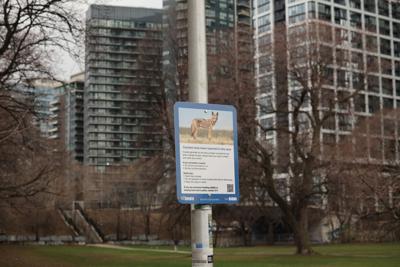The City of º£½ÇÉçÇø¹ÙÍøsays it made the “difficult decision” over the weekend to kill aÌýpair of coyotes that had been responsible for the deaths of multiple pets in the Liberty Village area.
The move followed a months-long campaign by some residents, and at an-times contentious debate with the city.
Officials did not say Tuesday exactly when or how the animals had been put down. The city had previously expressed reluctance to kill the coyotes, calling it a “last resort.”
For months, animal services workers and human-wildlife conflict-resolution specialistsÌýhad been patrolling the area, attempting to scare the coyotes off, on the advice of a panel of wildlife experts convened by the city back in March. That work may have succeeded in frightening off one of the four known coyotes in the area, the city said in aÌý. The remaining animal seems to have left of its own accord. Experts believe the surviving two were likely the offspring of animals the city had euthanized.
The city said the two coyotes had to die because they had become “habitualized to human interactions.”
The city said that was a result of factors that included the animals being intentionally fed by people, limited green space andÌýan abundance ofÌýgarbage and dog excrement in the areaÌý— whichÌýattracts both coyotes and the rats they hunt.ÌýThe male also appeared to have mange, an irritating skin condition caused by burrowing mites. The city said he was the one responsible for the “multiple negative encounters” with people and dogs. His mate was merely “present during some encounters,” the city said.
Local councillor Ausma Malik and MPP Chris Glover haveÌýsaid they believe the provincial governmentÌýripping up a tree grove at Ontario Place in the fall to put up a spa and parking lotÌýmay have displaced the coyotes and brought them in closer contact with people. Some wildlife experts say the theory has merit, but others have said it could have been any of the other recent developments in this young, dense neighbourhood.
The coyotes likely attacked and killed small dogs because they saw them as prey or weak rivals. Dogs in general are interpreted by coyotes as threats to their territory. Coyotes can also be more aggressive in the first quarter of the year, which is their mating season. They tend to partner for life and raise their young in tight, nuclear families. Coyotes have lived in the Liberty Village area for decades if not longer, according to a .
In February, some residents of Liberty Village formed the “Coyote Safety Coalition” and called for the animals to be removed,Ìý,Ìýholding a rally andÌýÌýbecause of what it said was Toronto’s “failure to address ongoing public safety risks.”
One of its most active members, Keith Patton, wrote on to the group’s Facebook page Tuesday that while the deaths of the coyotes “brings a degree of closure” they “arrived far too late for many.”
“The delayed response allowed preventable harm to continue, resulting in emotional trauma, the loss of cherished pets, and a significant public safety strain,” he said. The group said the coyotes killed five pets and were responsible for several dozen attacks.
City officials, meanwhile, have said the coalition had been difficult to deal with. Some members, they said, spread misinformation about coyote behaviour that may have endangered people and their pets. Whether or not dogs should be leashed was an open discussion among members online, some of whom theorized the coyotes may have preferred to attack leashed dogs.
That ran counter to expert advice and city guidelines.
Carleton Grant, the city’s head of bylaw enforcement and administration, which includes animal services, told the Star that while he “completely sympathizes” with the fear pet owners and victims must have felt, it was “terribly frustrating” some didn’t follow the rules.
The city’s wildlife expert panel had concluded that human and animal coexistence was possible in the area and preferable. The coalition questioned its credibility and findings, claiming they were “pro-wildlife activists.”
Animal advocates, meanwhile, accused the coalition of trying to portray coyotes as more violent than they really were.
Coalition leader Ruby Kooner, whose pet dog died after a coyote attack earlier this year, said in a statement to the Star thatÌýshe hopes wildlife advocacy groups “reflect on the consequences of minimization and inaction.”
“Downplaying the severity of the situation, or choosing not to engage in proactive planning, only accelerates harm — both to wildlife and to the residents being told to ‘coexist’ in increasingly dangerous circumstances,” she said. “Waiting until a situation becomes a crisis is not a strategy — it’s a failure.”
Ìý
Hilda Aywaz, a local who had hoped to coexist with the coyotes even after her own dog was attacked by one of them, said Tuesday she believes the city gave in to pressure to kill the animals. Aywaz said she wonders what will happen to the local rat population now that the predators have been killed.Ìý
“I blame the loudmouths,” she said. “The constant barrage of complaints. I guess the city had enough and decided this was the best way to handle the situation.”
Experts say an area that is suitable for coyote life is generally not vacant for long and that it is likely a new family of coyotes could soon move in.




























To join the conversation set a first and last name in your user profile.
Sign in or register for free to join the Conversation